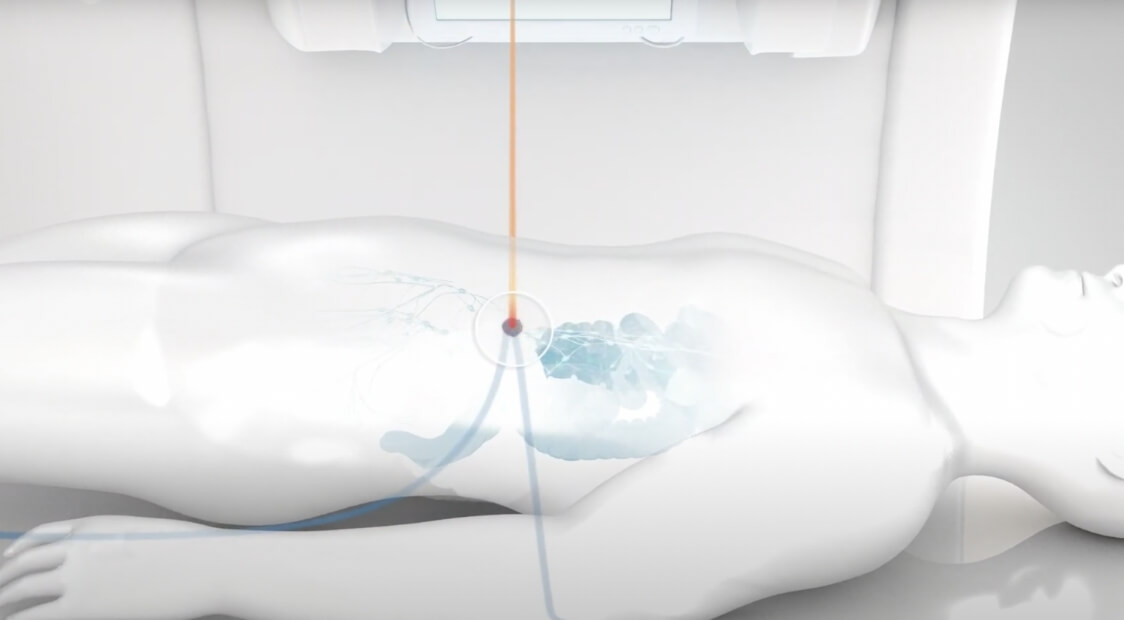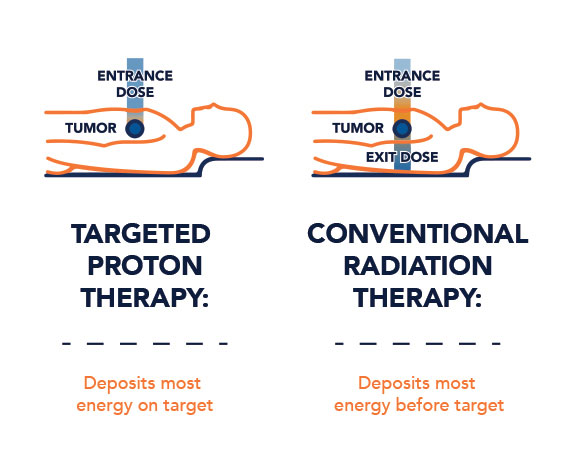What is the difference between proton radiation and radiation therapy?
By Bradlee Robbert
Share:

Cancer treatment is tailored depending upon the type of cancer, where it is in the body and other factors. Treatment is often a combination of treatments such as surgery followed by radiation therapy. If radiation is recommended, understanding the difference between proton radiation and radiation therapy can help in deciding how best to treat the cancer.
Patients meeting with a radiation oncologist will want to be ready to hear words like external beam radiation therapy (EBRT), intensity-modulated radiation therapy (IMRT), proton radiation therapy, dose distribution, treatment planning, Grey and toxicity. Learn more about these radiation oncology terms.
Most think of X-ray therapy when radiation therapy is necessary to treat cancer. However, proton therapy is another type of radiation therapy cancer treatment that uses precise high-energy beams to destroy cancer cells. Let’s look in-depth at proton therapy vs. radiation to treat cancer. Each radiation therapy technology can treat cancer; however, there are some key differences between the two treatments:
How Radiation Works
As explained by the American Cancer Society, radiation therapy uses high-energy particles or waves, such as X-rays, gamma rays, electron beams, or protons, to destroy or damage cancer cells. Your cells normally grow and divide to form new cells. But cancer cells grow and divide faster than most normal cells. Radiation works by making small breaks in the DNA inside cells. These breaks keep cancer cells from growing and dividing and cause them to die.
Types of Radiation
A type of EBRT (external beam radiation therapy) uses X-rays or photons to deliver the radiation dose to the tumor site. These photons have a wide range of energy and can penetrate through the body, affecting both the tumor and the surrounding healthy tissues.
X-ray therapy reduces radiation doses to normal tissue through a treatment delivery technique called IMRT. With IMRT, radiation beams are customized to minimize radiation exposure to normal tissue. However, IMRT still uses X-rays to treat cancer, and by doing so, the X-ray radiation enters one side of the body and exits the other.
Alternatively, proton radiation therapy uses protons, which are charged particles, to target the tumor. A charged particle is part of an atom and has mass. Because it has mass, the distance it travels can be predicted. It will only go as far as it is propelled and will stop, like a ball when it is pushed. Likewise, protons when propelled will stop at a predicted distance or target.
When protons stop, they release a burst of energy. This unique physical property is called the Bragg peak (image 1). Because protons deposit most of their energy when they stop at a specific depth within the body, the area being treated for cancer receives the majority of the radiation dose, and healthy tissue receives little or no radiation.
We can break down further what proton therapy vs. radiation therapy looks like. Proton radiation uses a similar technique to IMRT called pencil beam scanning. Pencil beam scanning is a type of external beam radiation therapy utilizing magnets to steer the proton beam, creating a customized, three-dimensional delivery shape. During treatment, radiation is deposited layer by layer, conforming the dose to the specific shape of your tumor and destroying cancer cells while preserving critical structures nearby.
Unlike X-ray radiation therapy, proton radiation therapy does not have an exit radiation dose. So, when protons enter the body from one side, they do not exit the body on the opposite side as X-rays do.

Dose Distribution of Proton Therapy Vs. Radiation Therapy
In radiation therapy, the dose delivered by X-rays gradually decreases as the radiation beam passes through the body. This means healthy tissues located before and after the tumor receives some radiation dose, increasing the risk of side effects.
Proton therapy, with its Bragg peak, allows for more precise dose distribution because the radiation stops in the body. There is no exit dose of radiation (image 2). This means nearby healthy tissue receives less or no radiation than traditional radiation therapy utilizing photons. This is said to be one benefit when looking at proton therapy vs. radiation therapy.

Treatment Planning
Radiation therapy treatment planning involves designing complex treatment fields to shape the radiation beams and optimize the dose distribution. It often requires multiple beams from different angles to achieve the desired dose coverage. X-ray therapy typically involves the delivery of more treatment fields to distribute lower doses of radiation into more normal tissue.
Proton therapy treatment planning is also complex, but it can provide more flexibility because there is not an exit dose of radiation. Specific beams can shape the dose distribution due to the unique physical properties of protons. This results in fewer treatment angles and less normal tissue exposure to radiation.
Cancers Treated with Proton Radiation Therapy
Approximately 50 percent of all cancer patients require radiation therapy treatment while managing their disease.1 Radiation therapy is a well-established, non-invasive, and widely available treatment option for several types of cancer. It is often effective to treat localized and widespread diseases.
Proton therapy is a more specialized form of radiation therapy and is used to spare radiation doses to radiosensitive structures. These could include surrounding tissues, organs, and glands. For example, a breast cancer patient may choose proton therapy to minimize radiation to their heart and lungs. At the Institute, we utilize proton therapy to treat some of the most common cancers, including prostate and breast, and we can also treat rare tumors, including chordomas and chondrosarcomas.
Patient Outcomes
More cancer patients in the United State are living longer.2 This means patients are looking for treatment options that have less side effects and contribute to a better quality of life after treatment.
In the May 2016 issue of the International Journal of Radiation Oncology Biology Physics the Institute published a study that reports five-year outcomes of more than 1,300 prostate cancer patients treated here from 2006 to 2010. The study shows that proton therapy is a highly effective treatment for low-risk, intermediate-risk, and high-risk prostate cancer. It also reports a low rate of serious side effects.
However, the benefits are not equal for all cancer diagnoses. Patients seeking radiation therapy should seek medical advice from a radiation oncologist to better understand the benefits of X-ray and proton radiation. This will help them make the best treatment plan for their cancer diagnosis.
It's important to note that when researching proton therapy vs. radiation therapy and making a choice for treatment there are many factors that go into that choice. These include the type and location of the tumor, the stage of the disease, the patient's overall health, and the availability of treatment options in the patient's geographical area. Finding the right treatment option is up to the patient and their care team.
Contact us to learn more about proton radiation and to talk to our cancer treatment experts to learn more about proton therapy for cancer.


